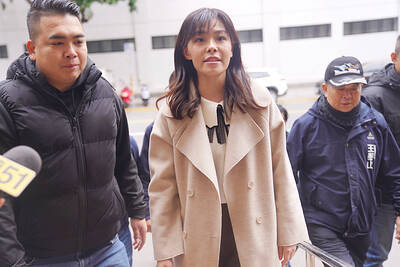The Ministry of Economic Affairs (MOEA) yesterday said that chips from Taiwanese semiconductor companies were not making their way into Chinese missiles “to the best of our knowledge.”
A report in yesterday’s Washington Post alleged that a Chinese company named Phytium Technology Co (飛騰) used chips made by Taiwan Semiconductor Manufacturing Co (TSMC, 台積電), along with US software, in advanced Chinese military systems.
“TSMC has long placed strict controls on their chips. The export of high-tech products from Taiwan is also highly regulated,” Minister of Economic Affairs Wang Mei-hua (王美花) said.

Photo: Zha Chunming / Xinhua via AP
“According to our understanding, none of the end uses for those products was military,” she added.
“To the best of our knowledge, TSMC’s exports not only meet Taiwanese standards, they also comply with applicable US regulations,” Wang said. “If information emerges that shows differently, we will of course investigate.”
Given the high volume of chip exports from Taiwan, the Bureau of Foreign Trade would educate exporters more to ensure that Taiwanese and international regulations are being followed, Wang said.
“TSMC has a rigorous export control system in place, including a robust assessment and review process on shipments to specific entities that are subject to export control restrictions,” the chipmaker said in an e-mailed response to the report.
“Moreover, TSMC has put in place processes to help identify abnormal circumstances in a transaction with due-diligence follow-up. With these processes already in place, we are not aware of a product manufactured by TSMC that was destined for military end-use, as alleged in the coverage,” it said.
The Washington Post article cites Ou Si-fu (歐錫富), a research fellow at the Institute for National Defense and Security Research (國防安全研究院), as well as an anonymous analyst.
Ou told the Taipei Times by telephone that he cannot speak specifically in regards to Phytium, but that the use of Taiwanese chips in Chinese military equipment would be “hard to trace.”
“The problem is that the chips are dual-use technology. They can be bought off the shelf for one application and then used in military equipment that is aimed right back at Taiwan,” Ou said.
Current Taiwanese and US safeguards for preventing Taiwanese chips from ending up in Chinese munitions are inadequate, Ou said, adding that meaningful measures for tightening up the flow of chips to China must come from the US.
“The US is ultimately in control of the upstream technology and equipment for the chips, even though Taiwan is the manufacturer,” Ou said. “They must be the ones to crack down.”
When asked whether Taiwanese can simply choose not to sell advanced chips to China, Ou said that it was unlikely.
“It would be asking them to voluntarily make less money and offend the Chinese at the same time,” Ou said.

The US government has signed defense cooperation agreements with Japan and the Philippines to boost the deterrence capabilities of countries in the first island chain, a report by the National Security Bureau (NSB) showed. The main countries on the first island chain include the two nations and Taiwan. The bureau is to present the report at a meeting of the legislature’s Foreign Affairs and National Defense Committee tomorrow. The US military has deployed Typhon missile systems to Japan’s Yamaguchi Prefecture and Zambales province in the Philippines during their joint military exercises. It has also installed NMESIS anti-ship systems in Japan’s Okinawa

‘WIN-WIN’: The Philippines, and central and eastern European countries are important potential drone cooperation partners, Minister of Foreign Affairs Lin Chia-lung said Minister of Foreign Affairs Lin Chia-lung (林佳龍) in an interview published yesterday confirmed that there are joint ventures between Taiwan and Poland in the drone industry. Lin made the remark in an exclusive interview with the Chinese-language Liberty Times (the Taipei Times’ sister paper). The government-backed Taiwan Excellence Drone International Business Opportunities Alliance and the Polish Chamber of Unmanned Systems on Wednesday last week signed a memorandum of understanding in Poland to develop a “non-China” supply chain for drones and work together on key technologies. Asked if Taiwan prioritized Poland among central and eastern European countries in drone collaboration, Lin

ON ALERT: Taiwan’s partners would issue warnings if China attempted to use Interpol to target Taiwanese, and the global body has mechanisms to prevent it, an official said China has stationed two to four people specializing in Taiwan affairs at its embassies in several democratic countries to monitor and harass Taiwanese, actions that the host nations would not tolerate, National Security Bureau (NSB) Director-General Tsai Ming-yen (蔡明彥) said yesterday. Tsai made the comments at a meeting of the legislature’s Foreign Affairs and National Defense Committee, which asked him and Minister of National Defense Wellington Koo (顧立雄) to report on potential conflicts in the Taiwan Strait and military preparedness. Democratic Progressive Party (DPP) Legislator Michelle Lin (林楚茵) expressed concern that Beijing has posted personnel from China’s Taiwan Affairs Office to its

BACK TO WORK? Prosecutors said they are considering filing an appeal, while the Hsinchu City Government said it has applied for Ann Kao’s reinstatement as mayor The High Court yesterday found suspended Hsinchu mayor Ann Kao (高虹安) not guilty of embezzling assistant fees, reducing her sentence to six months in prison commutable to a fine from seven years and four months. The verdict acquitted Kao of the corruption charge, but found her guilty of causing a public official to commit document forgery. The High Prosecutors’ Office said it is reviewing the ruling and considering whether to file an appeal. The Taipei District Court in July last year sentenced Kao to seven years and four months in prison, along with a four-year deprivation of civil rights, for contravening the Anti-Corruption